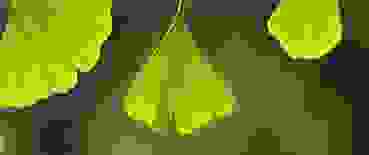
Ginkgo tree (Ginkgo biloba)
A living fossil, a motif in art and culture, an energising medicinal plant: many myths surround the ginkgo. Medicinally, ginkgo extract is used, among other things, to increase mental performance.
The ginkgo is considered a "living fossil", because the approximately 250 million year-old plant genus Ginkgo neither belongs to the deciduous nor to the coniferous trees, but represents its very own class of plants. Goethe wrote a poem about ginkgo leaves. The fan-shaped shape of the leaves is used as a template for jewellery and decorations. Ginkgo leaves also have a healing effect and are supposed to increase the brain's performance. Find out more about this ancient, Asian medicinal plant and its effects in this article.
Occurrence and distribution of the ginkgo tree
The Yangtze River is the longest river in Asia. It rises in Tibet and flows across the Chinese mainland, until it flows into the sea in the east of China near Shanghai. The ginkgo tree, Ginkgo biloba L., is native to the south-western part of the Yangtze River. In China, the tree has been used for millennia as a medicinal plant and temple tree. Therefore, Buddhist monks planted it in many areas. For example, Ginkgo biloba first reached Korea and Japan some 1000 years ago and then reached many other countries as well.
From the 18th century, the ginkgo spread as an attractive tree over much of the world. Again and again, you will find it in parks, in gardens and on streets. The reason is not only the attractive shape of the leaves, but also its great resistance to pests, pollutants, road salt and fungal diseases.
In this country you mainly plant the male trees, as the fruits of the female trees smell unpleasantly like rancid butter. In many Asian countries the reverse is true and female trees are preferred. Because there the fruits, which resemble a mirabelle plum, are freed from their shell. The seeds inside the fruit are peeled and cooked. It is either added whole to different dishes or chopped and used as a spice.
Appearance of the ginkgo tree
The ginkgo tree can grow up to 40 metres in height. In some cases it is even higher. However, it grows relatively slowly and takes many decades to reach such a height. The oldest ginkgo trees still present in Germany, Austria and Switzerland were planted here between 1750 and 1800 and are sometimes up to 50 metres high.
The ginkgo is a summer-green tree, the leaves of which turn yellow in autumn and fall off in winter. The most striking feature of Ginkgo biloba is its fan-shaped leaves, which are notched in the middle. The ginkgo is dioecious (has separated sexes). This means that there are male and female trees.
History and tradition of the ginkgo tree
In German-speaking countries, the ginkgo gained greater prominence and a romantic significance from the 19th century through Goethe. In his poem "Ginkgo biloba", which he dedicated to his lover Marianne von Willemer, Goethe placed two pressed ginkgo leaves and depicts the leaves, because of their two-lobed form, as a symbol of love and friendship.
The popularity of the ginkgo motif has not only been evident in art and culture, however. The ginkgo tree has also been highly valued as a medicinal plant and in Chinese philosophy. In ancient China, the tree was worshipped as being life-prolonging, healing and energising. The ginkgo is still credited as having miraculous powers in Japan and China today. It can fulfil wishes that are stated under it. The myth surrounding the ginkgo tree's powers was reinforced by a temple tree in Hiroshima. This was destroyed by the bomb explosion in 1945, but budded again in the same year.
Active ingredients and effects of the ginkgo tree
The dried leaves of the ginkgo are used medicinally. These contain flavonoids, diterpene lactones (ginkgolides) and bilobalides, among others. Together, these are supposed to protect the nerve cells from harmful influences and improve the blood flow in the smallest blood vessels in the brain, which influence memory and learning. In addition, the substances have an inhibitory effect on blood clotting, improve the flow properties of the blood and intercept free radicals.
Ginkgo as a medicinal product
The standardised extracts of ginkgo leaves are used to improve age-related cognitive impairments such as memory and concentration disorders, as well as in mild to moderate dementia. In addition, the medicinal plant can provide relief from dizziness, balance disorders and tinnitus. Moreover, ginkgo biloba is also used in the symptomatic treatment of peripheral arterial occlusive disease (intermittent claudication).
This is general information. For individual advice, please contact a specialist.
Modern herbal medicine
Modern herbal medicine (phytotherapy) combines centuries-old knowledge with the latest scientific findings.
Details

